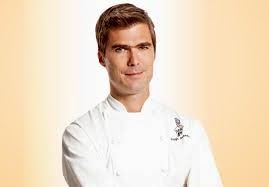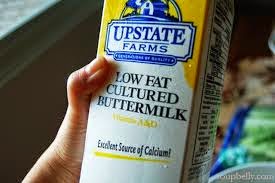Hugh Acheson is an Atlanta Chef who owns 5 restaurants there. His first cookbook “A New Turn in the South: Southern Flavors Re-Invented for Your Kitchen” (Clarkson Potter 2011) was awarded “Best Cookbook in American Cooking” by the James Beard Foundation in 2012. Not bad for a kid born in Ottawa, Canada. You may remember Hugh from his stints on Top Chef as a contestant and later a judge. He started working in kitchens at age 15 and he’s been drawn to them ever since. He ended up in Atlanta because his wife, Mary Koons, went back to her native Athens Georgia for Grad School. He’s clearly taken to the south and today’s recipe is a great example of his new style of southern cooking. First, the dish looks just beautiful. The peas and carrots pop from the plate and the big, juicy, crisp chicken gets its crunch from Crisco, which is about as Southern as you can get. It relies on the time honored use of Buttermilk to tenderize the meaty Chicken thighs. Why Buttermilk?
First of all, Buttermilk is not a butter-y high fat milk. Actually nothing could be further from the truth. Buttermilk originally was the liquid left behind when butter was being churned. That is traditional buttermilk but it doesn’t begin to cover the range of fermented milk drinks all called buttermilk. In warm climates from the Balkans to the Indian sub-continent, where unrefrigerated fresh milk sours quickly as well as in colder climates ranging from Scandinavia to the Czech Republic, buttermilk is made from fermented cow’s milk and is called “cultured buttermilk”. It’s made using two species of lactic acid bacteria which gives buttermilk its tartness. Cultured Buttermilk, which is what you’ll find in the supermarket, has several qualities that make it ideal for making chicken juicier and more tender and it helps the coating—in this case, flour—adhere to the chicken. The acid content in Buttermilk is responsible for tenderizing the meat. The marinating chicken does require a little time in the fridge. Chef Acheson recommends two hours but you could do this the night before. Or you could cut the marinating time down to an hour, which is the minimum time recommended elsewhere if not by Chef Acheson. One other change I made from the original: The peas were blanched, the carrots were raw. Sorry but I like a little more tenderness so I cooked these a little longer than the Chef recommended. Here is the recipe:
Recipe for Hugh Acheson’s Crispy Chicken Thighs with Peas, Carrots and Hot Butter Sauce
Four 1/2-pound, bone-in chicken thighs with skin
1 cup buttermilk
1 cup all-purpose flour
1 teaspoon kosher salt, plus more for seasoning
Pinch of cayenne
Pinch of dry mustard powder
1/2 cup vegetable shortening
1 cup fresh or frozen peas
3/4 pound bunch carrots with tops, tops reserved and carrots thinly sliced on the bias
1 tablespoon fresh lemon juice
1 tablespoon extra-virgin olive oil
1/4 cup small mint leaves
For the Hot-Sauce Butter:
2 tablespoons cider vinegar
4 tablespoons cold unsalted butter, cut into 1/2-inch cubes
2 tablespoons Louisiana-style hot sauce, such as Tabasco
1.
In a sturdy re-sealable plastic bag, combine the chicken and buttermilk and marinate in the refrigerator for 2 hours.
Preheat the oven to 425°. Place the flour in a large bowl. In a small bowl, stir the 1 teaspoon of salt with the cayenne and mustard powder. Remove the chicken from the marinade, letting the excess drip off, and transfer the chicken to a large plate. Season the chicken all over with the salt mixture.
Set a rack over a baking sheet. In a large cast-iron skillet, heat the shortening until it shimmers. Dredge the chicken in the flour, then fry over moderately high heat, turning, until deep golden, 7 to 8 minutes. Transfer the chicken to the rack and bake for about 25 minutes, until crispy and the juices run clear when a thigh is pierced.
2.
Meanwhile, in a small saucepan of highly salted boiling water, cook the peas and carrots until just done — about 3 minutes. Drain well and transfer to a medium bowl. Add the lemon juice, olive oil and mint. Chop enough carrot tops to make 1/3 cup and add to the bowl. Season with salt and toss to coat.
3.
In the saucepan, bring the vinegar to a simmer. Reduce the heat to low and whisk in the butter, one cube at a time, until incorporated. Whisk in the hot sauce and remove from the heat. Transfer the vegetables to a platter, top with the chicken and serve the buttery hot sauce on the side.






